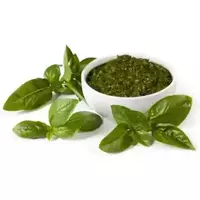Pickled basil

The main feature of the aromatic plant called basil is considered its exquisite taste and bright peculiar aroma worthy of kings. To date, breeders have bred a large number of various varieties of basil, whose progenitor was distinguished exclusively by green color.
Thus, cultural varieties of modern varieties of basil can please the eye with many shades of purple, although green varieties are still in stable demand and popularity among culinary experts and connoisseurs of this plant.
Interestingly, the victorious procession of the basilica around the world originates from the countries of South Asia, as well as Transcaucasia. Initially, this aromatic plant was cultivated in Ceylon, Iran and India, but over time the basil also reaches Europe (Italy, southern France and other regions).
Fresh basil leaves are commonly used as a savoury snack and fragrant seasoning. By the way, plant seeds are also used in Azerbaijani cuisine - thanks to them you can give a rather savoury aroma to various drinks, pates, salads or soups. In addition, basil greens are perfectly combined with dishes that are made with beef, offal, lamb or poultry.
Basil plays an important role in the aromatization of canned vegetables, sauces, marinades, oil and vinegar. The crushed greens of this fragrant plant are included in many aromatic compositions, as it is distinguished by a spicy aroma and a slightly cold, bittersweet taste.
The most fragrant are young plants (flowers and leaflets), although they collect basil throughout the warm season. However, basil leaves are recommended to be harvested before flowering, while flowers are at the very beginning. Most often, pickled basil is made for future use, or rather, fresh greens of this plant are preserved.
In order to prepare pickled basil at home, you need to cut entire plants at a height of 10-12 cm from the surface of the soil. Fresh basil leaves are carefully sorted, while yellowish, damaged and thick stems are removed. After that, the greens are poured with steep boiling water or blanched for about a minute over a high heat, thrown into a colander and, if desired, crushed with a meat grinder, knife or sieve.
The resulting basil mass is warmed up with the addition of salt, sugar and vinegar to taste, after which it is still hot in a suitable container and covered with lids. Jars of pickled basil are placed in a pan of hot water, sterilized and subsequently rolled up.
As a result, pickled basil turns out to be a rather original and tasty canned product, which can not only be added to a variety of first dishes, salads and snacks, but also used as a savoury side dish.
23 kCal marinated basilica
Energy value of pickled basil (Ratio of proteins, fats, carbohydrates - ju):
Proteins: 3.15 g (~ 13 kCal)
Fats: 0.64 g (~ 6 kCal)
Carbohydrates: 1.05 g (~ 4 kCal)
Energy ratio (bj | y): 55% | 25% | 18%
 Español
Español Français
Français Português
Português Русский
Русский 简体中文
简体中文 繁體中文
繁體中文 日本語
日本語 한국어
한국어 العربية
العربية Türkçe
Türkçe Қазақ
Қазақ Deutsch
Deutsch Italiano
Italiano Українська
Українська
